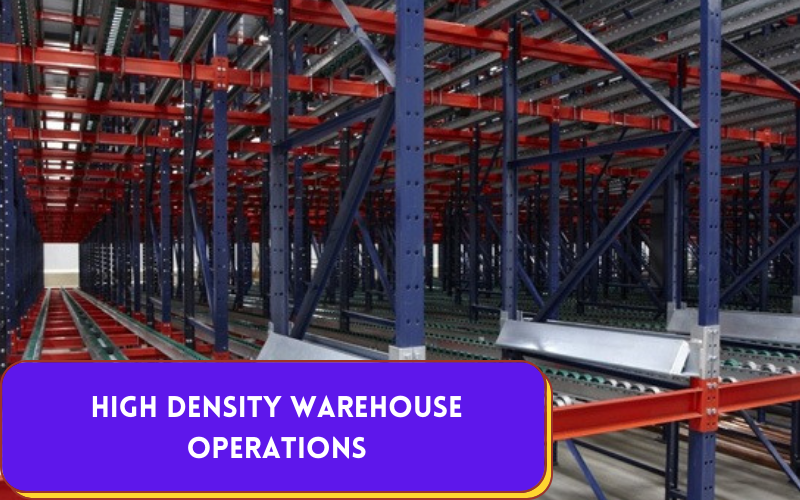With the rise of online shopping and the requirement for a statewide network of logistics and distribution centers, today’s reality necessitates space optimization. Pallet racking systems and picking solutions are available to satisfy this need.
The industrial storage systems industry has progressed through time from adjustable pallet racking systems to the contemporary reality of dynamic, versatile and adaptable systems to the needs of each organization.
There are several classification systems for different sorts of warehouse industrial racking systems. In this article, we’ll focus on non-automated storage systems such as push back racking for high density storage. For cartons or small products, pallet or pallet load racking and picking solutions are available.
High Density Pallet Racking System
Apart from those that provide direct access to each pallet, high-density pallet racking systems are one of the key groups of storage solutions utilized for warehouse fulfillment.
Because they are compact systems, they make better use of available space. They’re best employed, though, when there are a lot of pallets with the same SKU and rotation isn’t a big deal. Pallet flow racks are the only way to get FIFO (first in, first out) flows and precise rotation.
These storage arrangements do not allow for immediate access to any pallet. If the unit load is located internally, the pallets in front of it must first be relocated to gain access to it.
The wide side, perpendicular to the bottom skids, must carry unit loads. The exception is flow and push-back racking with rollers, which need the pallet to be loaded and unloaded from the narrow side.
How It Works
There must be only one SKU per lane (in high-density systems) or each level of a lane (Push-Back, Flow Racking and Pallet Shuttle Units). As a result, the gap between physical and effective capacity can be significant. The bigger the disparity between these capacities, the fewer lanes or levels are used for a single SKU.
Furthermore, having a management system does not always imply a gain in effective capacity using these systems. Because each lane is assigned to a single SKU, it is considered half full in a regular workflow, and its effective capacity is 50 percent of its physical capacity. When there is more than one lane, however, this difference becomes significant.
Finally, there are two critical considerations concerning the racking units’ height. The maximum construction height is limited by the usage of counterbalanced forklifts and reach trucks with these systems. Moreover, the more racking units there are, the more difficult it is to manage the pallets.
High Density Selective Pallet Racking System
If your business sells products such as liquor, chocolate, textiles, perfume, cigars, and jewelry, selective pallet racking is the ideal solution. The racking allows direct access to all products, which is critical in a warehouse with so many different SKUs.
Direct access helps operators manage the warehouse’s SKUs and pick orders more quickly. Because each site stores a single SKU, it also assures correct stock control.
You can benefit from the tiny push-back racks’ great selectivity and high-density storage, which allows it to store more products. This system’s nesting carriages can deep store up to five pallets at a time.
Operators place each pallet on the free-rolling carriage and push it back into the lane as more pallets are loaded. On the telescopic carriages, gravity propels the pallets ahead to the aisle during unloading. As a result, there is no need to reach or drive equipment into the rack.
- Operators can have easy access to the 20,000+ SKUs in the facility thanks to the bolted selective pallet racking.
- Increased storage capacity: the new storage solutions can enable your company to increase its storage capacity by more than 30%.
- High-density storage: your warehouse’s push-back racking allows the company to store more products while maintaining outstanding selectivity.
Pushback racking comes in a variety of depths, ranging from 2 to 6 pallet positions, and allows pallets to be placed on both sides of an aisle, allowing for more storage density than other pallet racking options.
By employing pushback pallet racking arrangements, a warehouse business can gain up to 25%–55% extra storage space without having to move to a larger automating warehouse.
By extending pallet locations vertically based on vertical clearance, lower profile constructed pushback racking can add even greater storage capacity to a warehouse.
Other Benefits of Pushback Racking System
- Fast Operation
In a warehouse, the elimination of aisles and the ergonomics of a pushback pallet racking system boost production and speed. The fork truck driver pulls the pallet off the forks, gently reverses, and the next pallet comes forward and into the front position utilizing gravity.
This technique can be repeated up to 6 pallets deep, obviating the requirement for forklift aisles and reducing forklift traffic. In a LIFO (Last-In-First-Out) storage application, direct access to pallet positions improves operational efficiency.
- High Selectivity
Pallet racking with a pushback design offers the best mix of storage density and selectivity. This racking allows pallets to be stored on both sides of an aisle without obstructing easy access to pallet positions.
Since pushback uses a LIFO inventory flow, SKU types and inventory diversity should be taken into account while installing pushback into a warehouse.
This warehouse pallet racking solution has a high density and selectivity, and it can be designed and adjusted to meet specific warehouse throughput requirements, warehouse space constraints, and storage density requirements.
Hence, your business will be able to improve its storage capacity by more than 30%, manage 20,000+ different SKUs, and receive 200+ incoming pallets each day thanks to such technologies.
So, what are you waiting for? Get a free consultation at MWI Solutions on how a pallet racking system can benefit your business.


One thought on “High Density Warehouse with Direct Access to Clean Up Operations”